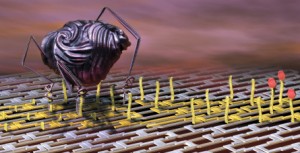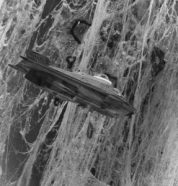Crawling, nano-sized robots
Built from DNA, these teeny bots move as directed

In 1966, scientists found a way to shrink anything — at least, they did in the movie Fantastic Voyage. In that film, a submarine and its crew were shrunk and injected into the body of a man. The man had been shot and was dying, and the tiny sub propelled around in his body in an attempt to save his life. The micro-crew did save his life, and the bad guy was eaten by a white blood cell. (Sorry for spoiling the ending.)
That movie was fiction — and far-fetched. A white blood cell will never consume a human being. It is true, however, that scientists are building tiny tools that will help in exploring the smallest parts of the real world. Some of these tools are called nanorobots, and in recent years researchers have been building nanorobots out of a familiar material — the same stuff that makes human life possible.
These nanorobots are built out of DNA, or deoxyribonucleic acid. (Words with “nano” usually refer to things as small as individual atoms or molecules.) DNA is literally all around (and in) you —you just can’t see it. If you were to look inside almost any cell inside any living creature, you would find DNA.
These nanorobots are made of DNA, and they “crawl” on DNA. (So sometimes researchers refer to these things as DNA “spiders.”) Being able to make such a tiny thing move in a certain way might be useful for health: A nanorobot could, perhaps, destroy just a cancerous cell, for example, but leave healthy cells alone.
DNA contains the basic directions for how to build the molecules that make life possible. From far away, a molecule of DNA looks like a jumbled mess. But up close, DNA looks like a spiral staircase. Each step of the staircase has two parts that are joined in the middle.
If you were to somehow break that spiral staircase apart, you’d have two curving sides with unconnected steps hanging off. (The steps are called bases.) Now imagine you have three or four of these DNA half-staircases, all connected at the top and dangling below.
Those half-staircases give you a simple picture of the legs of a DNA nanorobot. Each leg is made of half of a piece of DNA.

These ‘bots can’t walk on just any surface, but they can walk on other pieces of DNA. Scientists have found ways to fold the long, spiral molecules of DNA into other shapes: happy faces, for example and, more importantly, long tracks for the nanorobots. In a recent study, a DNA ‘bot took 50 “steps” across a track.
This might sound surprising — especially since these machines don’t need batteries or any power source. Instead, they work by using the natural structure of DNA.
Along the track are strands of DNA that stand up like hairs. These strands are attached to the track at the bottom. Just like the robot’s legs, the tracks are made of half-pieces of DNA — they resemble half-staircases with lots of broken steps. But while the spider DNA legs dangle down, the strands are attached to the track and rise up above it.
The DNA robot has half, and the track has half — so when the halves meet up, the stairs may join together. (Not always – these “stairs” must be carefully built.) This join-up is like a step for the tiny robot, and each leg can join with a floating strand from the track — the two fit together like puzzle pieces.
“The more legs you have, the stickier spiders are and the more steps they can take,” Milan Stojanovic told Science News. Stojanovic is a chemist at Columbia University in New York City, and he built the DNA nanorobot that took 50 steps.
To pick up its legs and take another step, the nanorobot has another molecular compound attached that acts like scissors. It snips the DNA strand on the track. Then, the whole staircase that had formed when the robot’s leg attached to the strand comes apart again, and the nanorobot’s leg is free — to go join up again with another free-floating piece of DNA attached to the track. In other words, the DNA nanorobot destroys the track as it goes.
“An automobile that chewed up the road behind it would be a bit unpopular,” Andrew Turberfield told Science News. Turberfield is a physicist at the University of Oxford, and he wants to build a reusable track for these tiny machines.
Nanorobots made from DNA aren’t useful yet, but they are impressive in the laboratory. One day, perhaps DNA-made machines will swim around in the human body, delivering medicine to diseased cells or helping doctors diagnose problems. Or maybe they’ll help build the smallest computers the world has ever seen.
The future is bright for DNA-built nanorobots, but one thing is for certain. We’ll never be able to shrink submarines to the size of cells, no matter what we see in the movies.
POWER WORDS
nano- Extremely small. One-billionth. (For example, one billion nanometers fit into one meter.)
robot A mechanical device capable of performing a variety of often complex human tasks on command or by being programmed in advance.
DNA A molecule that carries the genetic information in the cell and is capable of self-replication. DNA consists of two long chains of nucleotides twisted into a double helix and joined by hydrogen bonds between the bases. The sequence of nucleotides determines hereditary characteristics.
nucleotides Any of various compounds consisting of a nucleoside combined with a phosphate group and forming the basic constituent of DNA and RNA.







